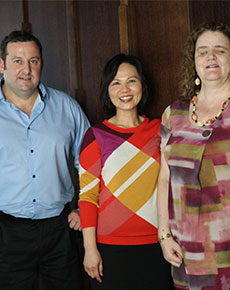Visual impairment at work – IT only part of the answer

Researchers from AUT’s Business School have shared the results of their research into the experiences of visually impaired professionals in the workplace and how those experiences are affected by information technology.
Associate Professor Angsana Techatassanasoontorn and Associate Professor Antonio Diaz Andrade from the Business Information Systems department at the AUT Business School are Co-Leaders of the Digital Mobility Research Group at AUT’s New Zealand Work Research Institute.
Their research began with a pilot study in 2014, where they interviewed eight individuals with visual or hearing impairments.
This was followed by an in-depth study in April-July 2015, where two professionals with visual impairments were interviewed along with their colleagues and line managers.
“In New Zealand 11 per cent of the population is affected by sensory impairments. The purpose of this research was to look at the role IT can and does play in improving the workplace experiences of those with sensory impairments,” said Assoc Prof Techatassanasoontorn.
“This qualitative study took an in-depth look at the experience of two visually impaired workers to understand how these workers utilise IT, and how close this takes them to the accessibility experienced by their fully-sighted colleagues.”
Peter Behr and Martine Abel were interviewed for the research.
Peter Behr, who works as a chef at MiCamp, Taupo, has lost his central vision and relies on his peripheral vision for everyday activities. He constantly uses an iPad to magnify labels and other objects in the kitchen, which he could not otherwise see. The technology Peter uses includes an iPad and iPhone with accessibility features, the Magnificent (magnifying) App and Dropbox.
Martine Abel is a Disability Advisor at the Auckland Council. She is completely blind and navigates her work environment with help from a guide dog and sometime her colleagues if she needs to attend offsite meetings. At work Martine relies on an iPhone with accessibility features, refreshable braille display and screen reader software.
“Sighted colleagues need to be mindful that our day-to-day tasks and work environment are designed for people with full sight. Flexibility, accommodation and support are key for workers with visual impairments. It is inevitable that every now and then we may come across ways of sharing information that are not accessible. It is crucial that organisations use these accessibility problems as a learning opportunity for improvement so we are moving in the right direction toward a workplace that is welcoming for all,” said Assoc Prof Diaz Andrade
The researchers hope to continue this line of research with professionals who have hearing impairments, to learn more about their experiences and challenges in the workplace.
AUT’s New Zealand Work Research Institute
Video about this research: https://youtu.be/Eoo4cd1q0Tk and https://youtu.be/FY3wlbpSngM (with subtitles).